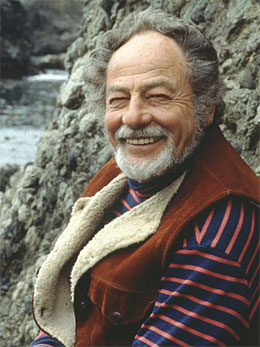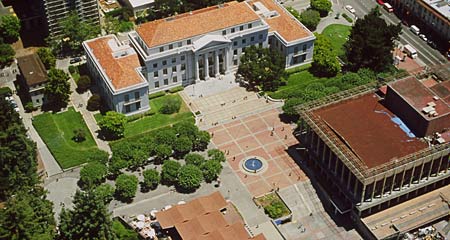Landscape designer who built Sproul Plaza leaves a national legacy
Lawrence Halprin, 93, helped shape the modern Berkeley campus
| 30 October 2009
BERKELEY — Before moving into the national spotlight with his bold urban designs, landscape architect Lawrence Halprin left a profound imprint on the Berkeley campus, from Sproul Plaza's rhythm of light and dark spaces to the graceful shape of Memorial Glade to the pedestrian-friendly entryways to the Greek Theatre.
 Lawrence Halprin
Lawrence HalprinFor several years in the mid-1950s, when his own design firm was a fledgling, Halprin served as Berkeley's supervising landscape architect.
Many of his most important contributions to the campus, ironically, were not all that well-received when he proposed them, according to Jim Horner, who has been Berkeley's landscape architect for the last 13 years.
Among the ideas Halprin laid out in his 1954 "Preliminary Report on the Landscape Plan" were eliminating most cars from campus, protecting areas around Strawberry Creek, adding cafés and other meeting places, and shrinking lawn space in favor of mulched areas, meadow, and ground covers, Horner relates.
At the time, temporary buildings had been erected up and down what's now called Memorial Glade, and Halprin recommended allowing the space to return to its natural bowl shape.
Horner met Halprin in 2000 when both men were part of a jury for the design of Wurster Hall's courtyard. When he introduced himself as campus landscape architect, Halprin told him: "No good ever came of that time," which Horner took as a wry comment on his plan's cool reception.
"But now 50 years later you can see that many of the ideas have happened," says Horner.
"He called the report 'preliminary' because he felt landscape design was never final and would always be changing," he adds.
Some of Halprin's ideas for Berkeley — sinking Gayley Road so the east and west sides of campus could be connected, and closing Bancroft Way at Telegraph Avenue to make a pedestrian mall — haven't been picked up and probably won't be, says Horner.
 Lawrence Halprin's dark-light-dark design for Sproul Plaza created "a rhythm of movement" for the stream of pedestrians passing through the central campus space.
Lawrence Halprin's dark-light-dark design for Sproul Plaza created "a rhythm of movement" for the stream of pedestrians passing through the central campus space.In 1958, Halprin's firm was hired to work on the renovation of the Greek Theatre, establishing its plaza and walkways. A year later, he did the courtyard spaces around what was then the dining commons for the new Residential Units 1 and 2; though the commons has been moved and more buildings added, Halprin's rock walls remain, according to Horner.
In 1962, when the southern edge of campus moved out to Bancroft, Halprin created the design for the large area facing Sproul Hall — a design that's endured through tumultuous, historic events as well as renovations to remain the most important campus meeting space.
"He established a new gateway to the campus using modern urban-design principles that anticipated the great flow of pedestrian traffic into the campus," says Horner.
The space has stayed true to Halprin's "dark-light-dark concept," as Horner describes it, though the original asphalt of has been replaced with dark pavers.
"As you enter off Bancroft, the light area is the brick forecourt, then you move into the dark asphalt shaded by the plane trees planted in an architectural pattern, then into the light center in front of Sproul Hall, open air and brick, and then again into the dark in front of the café.
"So there's a rhythm of movement through that space," Horner says.
The design served to emphasize the stairway up to Sproul and the plaza as a gathering space — a function it's served ever since, from the upheavals of the 1960s and '70s through the recent protest over budget cuts and the public celebration of President Barack Obama's inauguration.
Halprin went on to make a national name for himself, "pushing the design of America's urban spaces in a career that spanned 60 years," as San Francisco Chronicle urban-design writer John King put it in his obituary this week.
He maintained his vigor throughout his life, and some of his projects — the redesign of San Francisco's Stern Grove and the design of the Letterman Digital Arts Center in the city's Presidio — were completed within the last five years.
A public memorial for Halprin is in the works.

